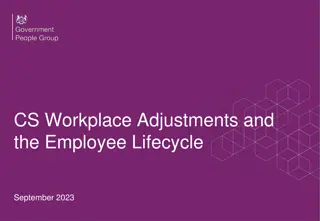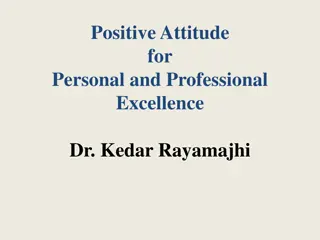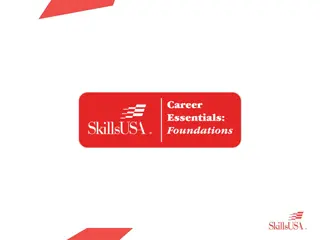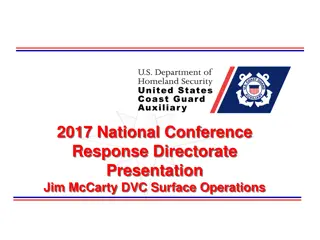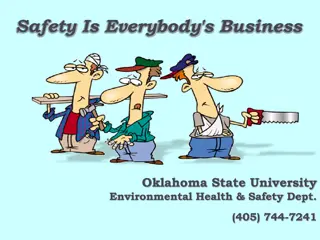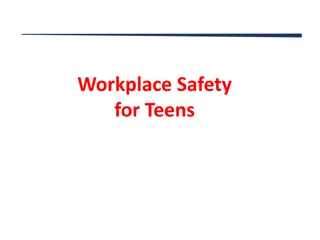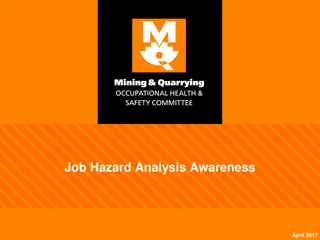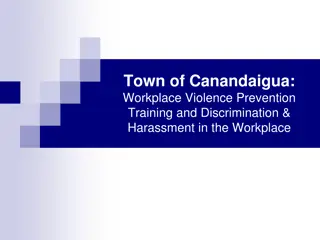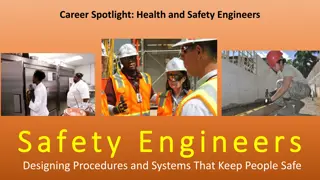Promoting Workplace Safety Through Attitude and Awareness
In the workplace, ensuring safety involves more than just eliminating hazardous conditions - it also requires addressing unsafe behaviors and fostering a proactive safety mindset. This content emphasizes the importance of cultivating a safety-oriented attitude, staying alert, recognizing potential hazards, and preventing injuries caused by complacency. By prioritizing safety training, awareness, and vigilance, organizations can create a culture that values and prioritizes the well-being of employees.
Download Presentation

Please find below an Image/Link to download the presentation.
The content on the website is provided AS IS for your information and personal use only. It may not be sold, licensed, or shared on other websites without obtaining consent from the author.If you encounter any issues during the download, it is possible that the publisher has removed the file from their server.
You are allowed to download the files provided on this website for personal or commercial use, subject to the condition that they are used lawfully. All files are the property of their respective owners.
The content on the website is provided AS IS for your information and personal use only. It may not be sold, licensed, or shared on other websites without obtaining consent from the author.
E N D
Presentation Transcript
WHAT IS IT ? Definition The condition of being safe. Freedom from danger, risk or injury Something we learn? Who? Something we see? When? A habit? How? **An Attitude**
Most accidents are caused by unsafe acts. You work hard to create a safe workplace for your workers and eliminate unsafe conditions. But what about employees' own unsafe behavior? If you examined your accident records for the past few years, you'd likely find that the root-cause of most of the accidents was unsafe acts rather than unsafe conditions. If you read between the lines of the accident reports, you might find that the workers involved in the incidents had become complacent about safety. They'd gone on "autopilot" and stopped paying attention to what they were doing. They'd taken shortcuts. They'd taken risks. They'd developed an "It won't happen to me" attitude.
What could go wrong If you are not thinking about what could go wrong every day, all day, while you work, you are not going to be completely safe. You need to be trained to think ahead as we approach each task and consider: What we are working with; What we are doing; Where we are going; What could go wrong;
Examine the substances Equipment, procedures, and situations that are part of their job and look for possible hazards. Remind yourself to be safe; Focus physically and mentally on your work; No matter how many times you may have done the same job. Impress upon yourself the fact that accidents occur in the blink of an eye. All it takes is one second of inattention, one moment of carelessness.
Stop complacency in its tracks. Complacency on the job injures and kills. Spreads like a disease from one worker to another. One employee sees a co-worker taking a shortcut and figures, "If he can do it, why can't I?" You can't afford to let complacency take over in your workplace. Complacency is dangerous as dangerous as any machine, chemical, or other recognized workplace hazard. Through a strong commitment to safety training and awareness, you can create a safety culture. Emphasis on alertness; Planning; Hazard identification; Problem solving, and; Injury prevention
If A,B,C,E,F,G,H,I,J,K,L,M,N,O,P,Q,R,S,T,U,V,W,X,Y,Z EQUALS 1,2,3,4,5,6,7,8,9,10,11,12,13,14,15,16,17,18,19,20,21,22,23,24,25,26
THEN K + N + O + W + L + E + D + G + E 11 + 14 + 15 + 23 + 12 + 5 + 4 + 7 + 5 = 96%
THEN H + A + R + D + W + O + R + K 8 + 1 + 18 + 4 + 23 + 15 + 18 + 11 = 98%
BOTH ARE IMPORTANT BUT THE TOTAL FALLS SHORT OF 100% HOWEVER A + T + T + I + T + U + D + E 1 + 20 + 20 + 9 + 20 + 21 + 4 + 5 = 100%
Safety is really about our ATTITUDE! Make 100% Safe Behavior your choice, both on and off the job every day!
POSITIVE OR NEGATIVE ? How does Attitude impact our lives?
ATTITUDE IS THE KEY A good attitude toward safety is a key to preventing unnecessary incidents and injuries. Your attitude affects your safety and the safety of everyone around you, both at work and at home.
ARE WE LEADERS OR FOLLOWERS? Leaders One that leads or guides or one who is in charge or in command of others. Follower A person who accepts the teaching of another, a servant or a subordinate, or one that imitates another. Can we be both? When Where How does this impact others around us?
WHAT DOES THIS MEAN FOR ME? We all have attitudes, We are leaders and followers; Our attitudes , our leadership, and as followers impact people around us; People observe what we do and follow our example; We train others good or bad habits; We create the culture which set the tone of our work habit; The culture includes bad or good attitudes, leadership, and training; We have the choice in our safety behavior; This decision impacts our ability to be safe and it also impacts the people that work with or around us.
MAKE A DIFFERENCE DO SOMETHING
Don't be a part of building this! DEAD DEAD SERIOUS INJURIES SERIOUS INJURIES MINOR INJURIES MINOR INJURIES REPEATERS REPEATERS Are at a higher risk Are at a higher risk NEAR MISS EVENTS NEAR MISS EVENTS UNSAFE BEHAVIORS BEHAVIORS Incidents breeds severity! 17
MY BEHAVIOR , MY CHOICES IMPACTS My Life My Family Co-Workers Friends Job Company




